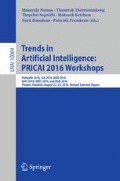Abstract
The importance of tourism information such as tourism purposes and tourist behavior continues to increase. However, obtaining precise tourist information such as the tourist destination and tourism period is difficult, as is applying that information to actual tourism marketing. We propose a method to classify Twitter user into tourist behavior and tourism purposes, extracting related information from Twitter posts. Our experiments demonstrated a 0.65 F-score for multi-class classification, showing accuracy for inferring tourist behavior and tourism purposes.
Access this chapter
Tax calculation will be finalised at checkout
Purchases are for personal use only
Notes
Refernces
Fang, G., Sayaka, K., Satoshi, F.: How to extract seasonal features of sightseeing spots from Twitter and Wikipedia (Preliminary Version). Bull. Network. Comput. Syst. Softw. 4(1), 21–26 (2015)
Bannur, S., Omar, A.: Analyzing temporal characteristics of check-in data. In: Proceedings of the Companion Publication of the 23rd International Conference on World Wide Web, pp. 827–832 (2014)
Burger, J.D., Henderson, J., George, K., Zarrella, G.: Discriminating gender on Twitter. In: Proceedings of the Conference on Empirical Methods in Natural Language Processing, pp. 1301–1309 (2011)
Rao, D., Yarowsky, D., Shreevats, A., Gupta, M.: Classifying latent user attributes in Twitter. In: Proceedings of the Second International Workshop on Search and Mining User-Generated Contents, pp. 37–44 (2010)
Burger, J.D., John C.H.: An exploration of observable features related to blogger age. In: AAAI Spring Symposium: Computational Approaches to Analyzing Weblogs, pp. 15–20 (2006)
Pennacchiotti, M., Ana M.P.: Democrats, republicans and starbucks aficionados: user classification in Twitter. In: Proceedings of the 17th ACM SIGKDD International Conference on Knowledge Discovery and Data Mining, pp. 430–438 (2011)
Cheng, Z., James, C., Kyumin, L.: You are where you tweet: a content-based approach to geo-locating Twitter users. In: Proceedings of the 19th ACM International Conference on Information and Knowledge Management, pp. 759–768 (2010)
Sloan, L., Morgan, J., Burnap, P., Williams, M.: Who tweets? Deriving the demographic characteristics of age, occupation and social class from Twitter user meta-data. PLoS ONE 10(3), e0115545 (2015)
Li, Y.R., Wang, Y.Y.: Exploring the destination image of chinese tourists to taiwan by word-of-mouth on web. In: Proceedings of World Academy of Science, Engineering and Technology, No. 79, p. 977 (2013)
Al Zamal, F., Wendy, L., Derek, R.: Homophily and latent attribute inference: inferring latent attributes of twitter users from neighbors. In: International Conference on Weblogs and Social Media, vol. 270 (2012)
Ishino, A., Nanba, H., Takezawa, T.: Automatic compilation of an online travel portal from automatically extracted travel blog entries. In: ENTER, pp. 113–124 (2011)
Vapnik, V.N., Vlamimir, V.: Statistical Learning Theory, vol. 1 (1998)
Benevenuto, F., Magno, G., Rodrigues, T., Almeida, V.: Detecting spammers on Twitter. In: Collaboration, Electronic Messaging, Anti-Abuse AND Spam Conference, vol. 6, p. 12 (2010)
Pennacchiotti, M., Ana-Maria, P.: A machine learning approach to Twitter user classification. In: International Conference on Weblogs and Social Media, vol. 11. No. 1, pp. 281–288 (2011)
Deerwester, S., Dumais, S.T., Furnas, G.W., Landauer, T.K., Harshman, R.: Indexing by latent semantic analysis. J. Am. Soc. Inf. Sci. 41(6), 391 (1990)
Acknowledgements
This work was supported by JSPS KAKENHI Grant Number 16K00157, 16K16158, and Tokyo Metropolitan University Grant-in-Aid for Research on Priority Areas “Research on social big data”. We are grateful for the assistance by Yoshiyuki Shoji.
Author information
Authors and Affiliations
Corresponding author
Editor information
Editors and Affiliations
Rights and permissions
Copyright information
© 2017 Springer International Publishing AG
About this paper
Cite this paper
Nozawa, Y., Endo, M., Ehara, Y., Hirota, M., Yokoyama, S., Ishikawa, H. (2017). Inferring Tourist Behavior and Purposes of a Twitter User. In: Numao, M., Theeramunkong, T., Supnithi, T., Ketcham, M., Hnoohom, N., Pramkeaw, P. (eds) Trends in Artificial Intelligence: PRICAI 2016 Workshops. PRICAI 2016. Lecture Notes in Computer Science(), vol 10004. Springer, Cham. https://doi.org/10.1007/978-3-319-60675-0_9
Download citation
DOI: https://doi.org/10.1007/978-3-319-60675-0_9
Published:
Publisher Name: Springer, Cham
Print ISBN: 978-3-319-60674-3
Online ISBN: 978-3-319-60675-0
eBook Packages: Computer ScienceComputer Science (R0)

